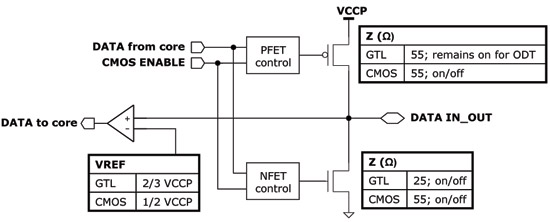Intel's Atom Architecture: The Journey Begins
by Anand Lal Shimpi on April 2, 2008 12:05 AM EST- Posted in
- CPUs
Atom's FSB and Multi-Core Aspirations
All Intel Front Side Buses (FSBs) use Gunning Transistor Logic; it produces a good signal that's clearly capable of reaching incredibly high speeds, presently up to 1600MHz. But remember, Atom isn't about being the fastest, just about being fast enough - leaving some room for improvement here.
A GTL FSB uses on-die termination to deliver a very clean data eye each clock, necessary when operating at very high frequencies. Atom isn't the most data hungry processor in the world and thus it can get by with a 400MHz or 533MHz FSB, thus the GTL FSB ends up being overkill.

Dual Mode FSB
Atom supports both a GTL or CMOS based FSB, the choice is made during manufacturing and a fuse is blown configuring the FSB for GTL or CMOS operation. When in CMOS mode on-die termination is turned off, the FSB runs at 1/2 the voltage of GTL mode and overall power is reduced. There are no performance tradeoffs to CMOS vs. GTL at the frequencies we're talking about here, the differences are only chipset compatibility and power.
Poulsbo can function in CMOS mode so you can expect Atom processors paired with the Poulsbo chipset to function in this lower power FSB mode. Atom won't be restricted to working with Poulsbo however, and the Diamondville core (Atom for cheap desktops and notebooks) is most likely Atom running in GTL mode so it can work with conventional desktop chipsets.
Atom is multi-core capable but obviously the first incarnation is a single-core design. The first manifestation of a multi-core Atom will be with a dual-core Diamondville due out later this year. Like previous dual-core CPU designs, Atom will place two cores behind a shared FSB. Once it gets an integrated memory controller, the multi-core designs will be more elegant.










46 Comments
View All Comments
lopri - Thursday, April 3, 2008 - link
This article is as much propagana-ish as it is technical. Did you read the last page of the article?clnee55 - Friday, April 4, 2008 - link
Since Anand wrote this article. I let him answer your accusationGulWestfale - Wednesday, April 2, 2008 - link
i believe that the graphics core in the chipset is a powerVR gen5 derivative; intel already uses some of their tech in its existing mainboards and wikipedia states that intel has licensed gen5 tech for one of its chipsets, the GMA500 (which is the same as poulsbo?) gen5 is also DX10-capable, which matches the info in your article.http://en.wikipedia.org/wiki/PowerVR#Series_5_.28S...">http://en.wikipedia.org/wiki/PowerVR#Series_5_.28S...
yyrkoon - Wednesday, April 2, 2008 - link
and wikipedia has been known to be wrong . . . a lot lately it seems.My point here *is*, I would probably trust anandtech more than wikipedia now days, as it seems any Joe can put up a 'reference' without citation.
jones377 - Wednesday, April 2, 2008 - link
Following the references link from the Wiki article...http://www.imgtec.com/News/Release/index.asp?NewsI...">http://www.imgtec.com/News/Release/index.asp?NewsI...
Poulsbo uses a PowerVR 3D core
Anand Lal Shimpi - Wednesday, April 2, 2008 - link
Yep, you guys are correct, I wasn't aware that it was public yet :) I've updated the article.Take care,
Anand